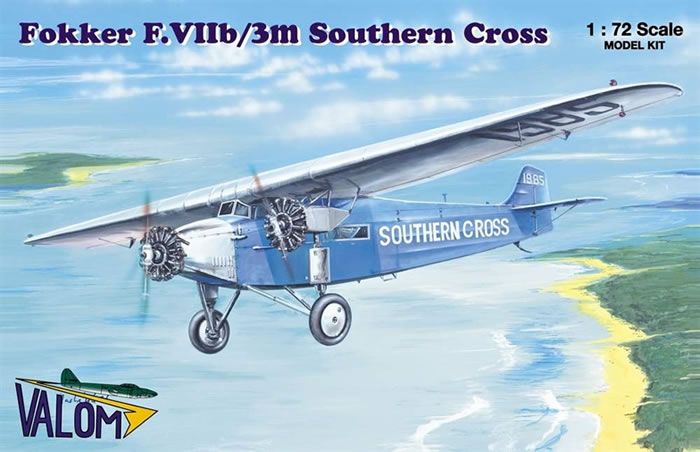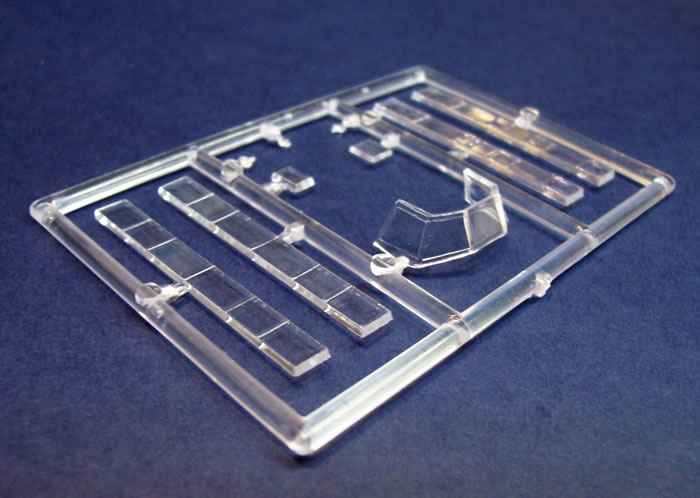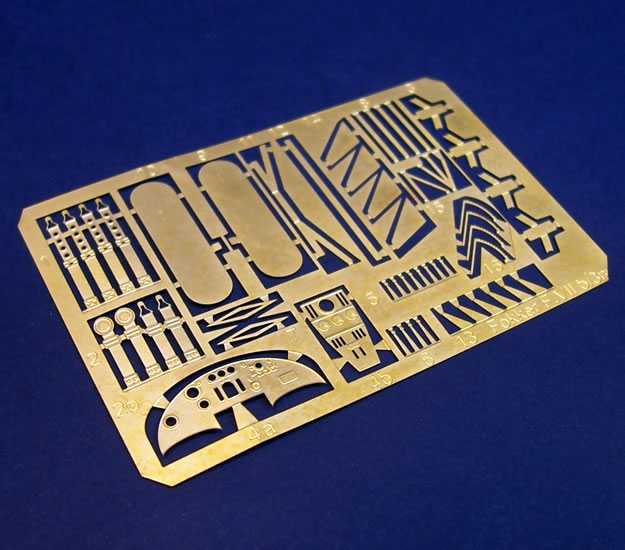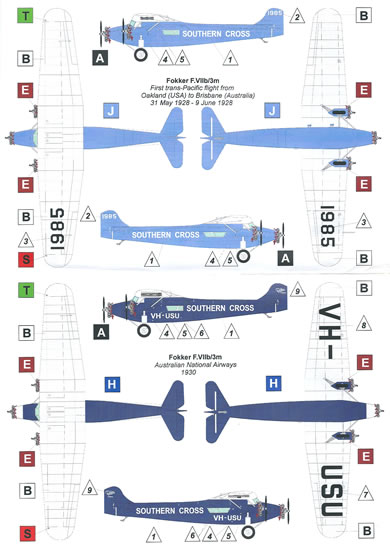|
Fokker F.VIIb/3M
Southern Cross

Valom, 1/72 scale
S u m m a r y : |
Catalogue Number: |
Valom Kit No. 72072 - Fokker F.VIIb/3M Southern Cross |
Scale: |
1/72 |
Contents & Media |
8 clear styrene and approximately 54 tan styrene parts, 5 resin parts, 1 PE fret with 52 parts, plus decals for 2 subjects. |
Price: |
Available online from: |
Hannants |
Modelimex |
Red Roo Models |
£30.83 |
€24.58 |
Au$36.00 |
Review Type: |
First Look. |
Advantages: |
Good resin engines, generally straightforward construction, helpful colour call-out cross-referencing. |
Disadvantages: |
Fine engraved lines all over the wings, which I think should instead appear smooth, or possibly very slightly raised to represent doped tape. |
Conclusions: |
This is a generally well-executed limited run kit of an historic subject. My comments regarding the wing surface detail may be overstated, but ultimately it will be for the builder to judge how much weight to attach to my opinion. I recommend this kit as the best available for a good model of the Southern Cross. |
Reviewed by Mark Davies

Valom's 1/72 scale Fokker F.VIIb/3M is available online from Squadron.com
Background
The Fokker F.VII followed the unsuccessful F.V (the F.VI designation applied to a fighter the US Army was interested in). Both were airliners with a thick ply covered wing, but the F.VII reverted Fokker’s usual fabric over steel tube rather than the ply covered fuselage used on the F.V. The single engine F.VII soon underwent some aerodynamic cleaning up to become the F.VIIa. This aircraft received a simpler three-strut undercarriage and rounded wingtips. Designed to accept a wide range of inline and radial engines, the F.VIIa ensured it appealed to a wide range of customers with either specific power preferences or Government-mandated engines. This feature had a significant effect on the success of the F.VIIa.
The Fokker F.VIIa/3M was an F.VIIa modified to a tri-motor layout in order to participate in the 1925 Ford Reliability Tour, which it won. Edsel Ford purchased this aircraft following the tour, and the 1926 Byrd Antarctic Expedition used it fitted with skis. It now resides in the Ford Museum.
Production of the F.VIIa/3M tri-motor variant followed quickly, and all subsequent single-engine F.VIIa’s produced also had underwing attachment points for three different engine types to enable rapid conversion to tr-motor layout if desired.
One of the first buyers of the new F.VIIa/3M was the explorer Sir Hubert Wilkins. He requested extended span wings for use on long-range exploratory flights. The US Army also opted for this extended span version, which with other military modification became the C-2. It was this longer span design, known as the F.VIIb/3M in civil use, that became the most popular and widely used of the F.VII family. The easiest way to distinguish between the F.VIIa/3M and b/3M variants is that the former’s wing trailing edge tapered in a straight line root to tip, whereas the latter’s wing did not begin to taper until outboard of the wing engines (also, the nose engine of the F.VIIb/3M had a slight downward inclination).
Adopted by numerous airlines and manufactured under licence in seven countries, the F.VIIb/3M also became widely associated with record setting and long distance flights during the 1920’s and 30’s. Sir Charles Kingsford Smith flew one of the most famous F.VIIb/3m’s named the Southern Cross. This made the first trans-Pacific flight between the USA and Australia in June 1928, and the first trans-Tasman return flight between Australia and New Zealand in September of that year.
Re-registered as G-AUSU for a year, the Southern Cross then became VH-USU in July 1929 and was operated by Australian National Airways, an airline founded by Sir Charles Kingsford Smith and his Southern Cross co-pilot Charles Ulm. They operated VH-USU and five Avro 610s (UK licence-built F.VIIB/3M’s). VH-USU retained its name of Southern Cross and the five Avros were all given names beginning with Southern. The airline folded in 1931 following the crash of an Avro 610.
The Southern Cross came out of retirement briefly in 1945 for use in the movie “Smithy” about Sir Charles Kingsford Smith. A replica Southern Cross flew in South Australia in the 1980’s, and the restored Southern Cross is now on display in the Kingsford Smith Memorial near Brisbane Airport.
Previous F.VII Tri-motor Kits
Frog released a Fokker F.VIIb/3m as a Southern Cross boxing within the Frog Trail-Blazers series in the 1960’s. The box-art showing the Southern Cross almost touching the whitecaps as it skims the ocean is surely an iconic modelling image to many British Commonwealth modellers of my generation at least. Several Eastern European kit makers have reissued the Frog kit, the most recent re-box being by Zvezda within the last year. Broplan released a vac-form in the early 1990’s of a Polish military version with dorsal gunner’s station, and they may have offered other variants too.
Valom released its first F.VIIb/3M kit around two years ago, and different boxings covering various European operators and a Spanish Civil War bomber version now total eight. The kit reviewed here essentially continues the theme of exploiting the plethora of interesting schemes and variations this subject offers.
This boxing offers two versions: the Southern Cross, registration number 1985, as flown by Smith across the Pacific Ocean and Tasman Sea, and the same aircraft in its later guise as Southern Cross VH-USU operated by Australian National Airways in 1930.
Valom thankfully adheres to the widely preferred top-opening box for its kits, unlike most European kit companies who tend to use the end-opening variety. The contents are contained in a resealable cellophane bag, with the decals, PE fret, transparencies and various resin parts further contained in their own small bags. The instructions are typical for Valom, featuring a coloured painting and markings guide, an aircraft history in Czech and English, along with a parts map and diagrammatic assembly stages. The assembly instructions are generally adequate, but no more than this. The parts map would be more helpful if it crossed or blanked out the numerous parts not required by this boxing. (They do cross three parts out, but overlook 20 or so more that are not required.) Nevertheless, a commendable Valom feature is the cross-referencing of colour call-outs to FS-595b and the paint ranges of Humbrol, Agama, Model Master and Gunze Sangyo.
The parts are typical for a Czech limited-run kit and roughly on par with brands like Special Hobby or AZ Model but a bit better than Pavla. As with other Valom kits I have reviewed some flash is present but easily dealt with, and detail is generally well defined. Nicely detailed resin engines with a fair amount of flash, resin wheels, acceptably clear transparencies and a good PE fret round out the parts tally.

Surface detail on the fabric covered fuselage and fin looks realistic compared to photos, although the horizontal stabilizer fabric is maybe a bit saggy in appearance. I am less convinced regarding the way Valom has rendered the wing surfaces however.
The kit’s wing has quite light grooves scribed along what are presumably rib and spar lines. If the original had a metal wing these lines would be acceptable in kit form as engraved panel lines, but it was not a metal wing. The wing construction instead followed standard Fokker practice using a wooden structure skinned with plywood panels. I have studied several images of F.VIIb/3M’s including some showing the wing surface very clearly, and it is quite smooth in appearance as can be seen here. I think the lines correspond with where the plywood skin fixes to the wing’s internal structure, and I suspect that they may be doped tapelines standing out due to a lighting effect (doped fabric may have covered the ply wing surface as this finishing method was used on ply covered airframes).

I think that Valom’s inscribed lines give a somewhat exaggerated appearance, if indeed the lines ought to be present at all in 1/72-scale. Despite this criticism, I can see many choosing to accept the lines as they are because they are very fine, and might be preferred to the plain appearance of an overall smooth wing. After all, surface detail in this scale is often a compromise between blandness and authenticity.
The standard kit sprues already include several choices of propellers, cowl rings and engine exhausts whilst resin parts cater for the differences in engines across the various boxings. However, this boxing has two small additional sprues with additional engine nacelle, tailfin and undercarriage parts specific to the Southern Cross.
Assembly will hold few surprises, but it is fair to expect some fit challenges because this is a limited run kit after all. The flight deck has adequate detail for the scale, using PE and acetate foils for the instrument panels, along with PE seatbelts, rudder pedals and throttle levers.

The flight-deck floor, rear bulkhead, seats and control wheels are made of styrene. The passenger cabin has some separate tubular framework where it will show through the windows and passenger seating. The instructions imply the passenger seats apply to both versions, but I would think it unlikely that the record setter used them, and more likely had extra fuel tanks in their place (if anyone knows for sure please contact me). It is likely that very little of the cockpit and cabin detail will be seen when the model is completed.
The fuselage halves look as though they should be a good fit, although the fuselage window apertures need a little cleaning up and care to get a neat finish. There is a need to fill and paint over some of the kit windows as provided because the Southern Cross had less glazing than the standard aircraft. The wings with their separate ailerons and the empennage should be a breeze to assemble, leaving the engine nacelles and undercarriage as the most challenging aspect of assembly.
The two additional small sprues provide a choice of engine nacelle style specific to either the record setting or airline version of the Southern Cross. These lack locating holes for their associated mounting struts, but the instructions give dimensional advice as to where to drill these. The instructions devote quite a few diagrams to guiding nacelle and support strut assembly, and generally do a reasonable job, but I still recommend some careful study of these and the parts before breaking out the cement. Nicely done resin engines with delicate exhaust stubs are finished off with quite good-looking two-blade props complete this aspect of assembly.
Not many parts remain to describe and account for. The additional sprues provide the squared off fin and rudder to replace the more typical Fokker curved style one.
The small sprues include different main undercarriage legs to the kit’s usual options. These have separate two-piece compression chamber fairings whereas a single-pieces moulding would be more typical. Tailskid, tail struts, some kind of ventral vent or drain, nav-lights and wind-driven generators will likely be the last plastic parts to fit, and of course the resin wheels. All that remains after this to fit is a number of PE control actuators and linkages.

The kit supplies two similar decal options covering the Trans-Pacific flight and Australian National Airways service in 1930. Aside from with different serial numbers there is a difference in the blue paint used for the fuselage, the later airline scheme being much darker.

The decals have very good registration and suggest good opacity.
I suspect the Fokker F.VIIb/3M kits series is a successful one for Valom as they have now issued eight different boxings. The Southern Cross release should prove popular, and I cannot help but wonder if we will see some other record breaking and exploration editions perhaps pitched at the US market in due course.
Assembly looks to be straightforward after allowing for the kit’s limited run nature. There is still quite a bit of room for Valom to improve their instructions, although this kit’s are at adequate if not as user friendly as they might be. My discussion of the fine lines on the wings is lengthier than perhaps their significance warrants, as after all surface detail is at best a simulation or representation of the real thing. I would not want it regarded as an obstacle to finishing a nice model from this kit, which I happily recommend.
Now if only Valom would consider offering a Fokker F.XX, or better still an F.32...
References:
Fokker – Than Man And The Aircraft, Harleyford Publications 1961
wikipedia.org
Thanks to Valom for this review sample.
Review Text and Images Copyright © 2011 by Mark Davies
Page Created 2 August, 2010
Last updated
24 April, 2012
Back to HyperScale Main Page
Back to Reviews Page

|
